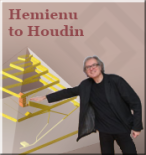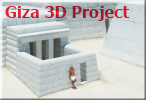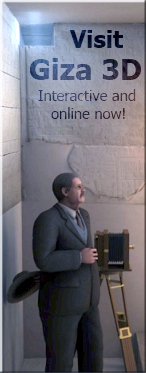 One of the most contested aspects of the architecture of the Great Pyramid is the function of the relieving compartments (or chambers) stacked above the King’s Chamber. Do they serve a strictly symbolic purpose? Do they represent, as has been suggested, the Djed Pillar, or some other sacred configuration? Or do they serve a structural purpose, despite adding seemingly unnecessary weight atop the King’s Chamber?
One of the most contested aspects of the architecture of the Great Pyramid is the function of the relieving compartments (or chambers) stacked above the King’s Chamber. Do they serve a strictly symbolic purpose? Do they represent, as has been suggested, the Djed Pillar, or some other sacred configuration? Or do they serve a structural purpose, despite adding seemingly unnecessary weight atop the King’s Chamber?
French architect Jean-Pierre Houdin sees the answer in the arrangement of internal elements of the pyramid’s architecture still hidden from plain view, but discernable by other architectural and material oddities, such as the relieving compartments themselves. Why were they so high? What purpose did raising the pressure points serve?
This is the fifth in a series of fascinating dialogues held between writer Marc Chartier, of the website Pyramidales, and Jean-Pierre Houdin following the premier of Khufu Reborn, the next chapter in the unraveling the mysteries of the Great Pyramid and the Giza Plateau. This series of articles is being provided in English for Em Hotep in an exclusive arrangement with Marc, Jean-Pierre, and the Project Khufu team at Dassault Systèmes.
 I do not think this will be a scoop for anyone: the King’s Chamber in the Great Pyramid is topped by an imposing and complex superstructure, made from five so-called “relieving chambers”, supposed to protect it from hypothetically crushing the last remains of the Pharaoh nestled in the heart of the monument.
I do not think this will be a scoop for anyone: the King’s Chamber in the Great Pyramid is topped by an imposing and complex superstructure, made from five so-called “relieving chambers”, supposed to protect it from hypothetically crushing the last remains of the Pharaoh nestled in the heart of the monument.
Even those uninitiated into the subtleties of the art of Egyptian construction can easily feel how much these masses and spaces capping the funereal chamber could and still can fuel debates between Egyptologists or pyramidologists. (This latter term is sufficiently vague that it usefully covers an entire army of researchers trying to understand the hows and whys of the Egyptian pyramids).
In particular, among other good questions, why a “simple” raftered vault would not have sufficed, as in what is called the “Queen’s Chamber” – also intended to house the mortal remains of the Pharaoh at some time in the pyramid’s history, and on the face of it subject to the same volumetric compression? What is the “security” bonus of this stack of utterly enormous monoliths?
We will skip over the thorny question of the cracks that appeared in this enormous structure: this is not relevant here. Moreover, Pyramidales has already made a contribution on this subject, unwittingly stirring up a pretty unhealthy controversy just where the search for knowledge is called for, to the exclusion of any favoritism or personal bitterness.
As the five superimposed chambers are not there purely for style, nor in answer to any gratuitous challenge the Egyptian builders might have set themselves, but really are important pieces of the gigantic pyramid “puzzle”, Jean-Pierre Houdin could not disregard them in his Khufu Reborn (aka Khufu Renaissance) reconstitution of the Great Pyramid’s construction. Quite the opposite, he recognizes their essential role, without which part of the “puzzle” could collapse.
Let’s summarize what we already know from Khufu Reborn. Following Jean-Pierre Houdin along what he calls the “Noble Circuit” (corridors and structures deep within the pyramid intended for the royal funeral procession), we have discovered two antechambers in front of the King’s chamber, then an access corridor running up to the “formal” entrance to this chamber, distinct from the service entrance.
The architect then continues his reading of these places, using a totally new approach. In his opinion, the relieving chambers were not designed to be, as is generally thought, a cascade of bulwarks to prevent the King’s chamber caving in. Their construction and disposition must rather be associated with the existence of the two corbel-vaulted antechambers, ensuring their stability by protecting them from the effects of transferred load.
A major technical challenge
 According to Jean-Pierre Houdin, the major technical challenge that must have faced Hemiunu and Ankhhaf, the architects of the Great Pyramid, derives directly from their decision to build a flat ceiling for the King’s chamber. This innovation was fundamental… but it did not make the task easier! It is the very key to the special nature of the monument’s construction and the raison d’être for some of its main structures, such as the Grand Gallery, for example.
According to Jean-Pierre Houdin, the major technical challenge that must have faced Hemiunu and Ankhhaf, the architects of the Great Pyramid, derives directly from their decision to build a flat ceiling for the King’s chamber. This innovation was fundamental… but it did not make the task easier! It is the very key to the special nature of the monument’s construction and the raison d’être for some of its main structures, such as the Grand Gallery, for example.
“From one pyramid to the next,” comments Jean-Pierre Houdin,
Egyptian builders kept what was successful, abandoned what they considered not so good and, above all, took advantage of the opportunity to try new construction techniques. For the Great Pyramid, they kept corbelling for the antechambers and set themselves a gigantic challenge: that of offering their king, Khufu, a funereal chamber with a flat ceiling. This was a technical feat that they had never before attempted.
The entire organization of the project depended on this bold choice. The architects ordered materials from different quarries, from those at Tura for the facing blocks, from those at Aswan, more than eight hundred kilometers to the south, for granite for the King’s Chamber. This granite was the only material capable of spanning a void of some 5.20 m between the north and south walls of the chamber. The quarrymen could not deliver the beams to Giza at the start of construction because it would take years to extract and transport them. While they got down to their work, the monument was taking form. The beams would all have to be delivered to the site by the fourteenth year of Khufu’s reign at the latest, the pyramid having then reached a height of 43 m.
Jean-Pierre Houdin then made a detailed examination of the consequences, in terms of cost and technological progress, of the architectural choice governing erection of the Great Pyramid, which had a funereal chamber that until then had not featured on any architect’s plans:
The Egyptians did not order granite beams from Aswan for the pleasure of hiding such a quantity of beams inside the bulk: 2,100 tons altogether in the 43 beams distributed over 5 ceilings between level +48.85 m and level +60.15 m.
Exceptional technical resources were deployed to bring them from the banks of the Nile to their final position: between the levels of the delivery port (altitude 20 m ASL) and the last ceiling (altitude 100.15 m ASL), an uphill haul of more than 80 m!
Exceptional resources for an exceptional project
Major resources for a major project. Indeed, exceptional resources for an exceptional project. According to Jean-Pierre Houdin, the construction of the Great Pyramid required nothing less than:
- the construction of a ramp more than 600 m long (in red on the sketch above) between the port and the bottom of the Great Pyramid’s exterior ramp (in blue on the sketch);
- the installation of a counterweight-assisted traction system by cutting a huge trench in the bedrock (later buried under the pyramid of Khafre: in green, in the middle, on the left on the sketch) as an extension of the ramp coming from the port (Pyramidales will return to these technical aspects in a future article);
- construction of the Grand Gallery (in green, on top on the sketch) , a real built-in “crane”, as a second counterweight-assisted traction system to bring the beams into the pyramid enclosure for the construction of the ceilings;
- creation of an entire series of additional structures (ascending corridor no. 1, horizontal corridor no. 1, portcullis chamber), needed to operate the counterweight.
This is what it cost to implement the ambitious plans of the architects for the Pyramid of Khufu! “The construction of a corbelled roof for the King’s Chamber,” comments Jean-Pierre Houdin,
would not have required any of these facilities, and there would never have been any granite in this pyramid. To have brought granite into the pyramid, the only material capable of spanning a void more than 5 m side and thus the only material to allow the construction of a flat ceiling, is the result of an architectural choice.
The “umbrella” effect
At this stage in our reading of the architectural plan for the Great Pyramid, guided by Jean-Pierre Houdin, a question arises: Hemiunu and Ankhhaf decided to install a flat ceiling on the King’s chamber. So be it! But why were they not content with just one ceiling, then capping it directly with a raftered vault, the only structure to deflects loads laterally, rather than transmit them vertically downward?
With such a hypothetical single ceiling surmounted by its inverted “V” vault, the Grand Gallery with its corbelled vault constructed parallel to the slope would not have seen its stability threatened in the slightest. The location of the Grand Gallery on a projection of the northern rafters of the roof at a slope of 50% would have been structurally equivalent, for example, to a buttress of a Gothic cathedral. The gallery therefore certainly did not require the installation of additional relieving chambers.
Let’s read our architect-guide’s explanations: “Rafters transfer loads along an oblique, and if there had been only the Grand Gallery in the zone receiving the oblique load, it would have had no difficulty ‘absorbing’ it.
“There are three reasons for this:
- the Grand Gallery is aligned with the oblique load and, given its very imposing structure, it reacts as an abutment (it is even stronger than the surrounding ‘in-fill’);
- the empty part of the Grand Gallery (2 cubits: the width of the last corbelling) only receives the oblique load over half of each rafter, which is positioned so that the other half is butted against the side walls of the Grand Gallery;
- given the position of the Grand Gallery entirely to the east, the rafters transfer more than 90% of the northern oblique load into the ‘in-fill’, compared with 100% of the southern rafters’ load.
“Conclusion: there would be no structural reason for the structure of the relieving chambers, as constructed, if there were only the Grand Gallery to consider.”
The relieving chambers were not therefore constructed to protect the Grand Gallery, although the Grand Gallery was built to transport and position the monoliths for the five load-deflecting chambers.
From this it follows that the reason for the relieving chambers must be sought elsewhere. And this “elsewhere” is called the “antechambers”, an essential part, according to Jean-Pierre Houdin, of the funereal architecture in the “Khufu’s Inheritance” version (see previous article from Pyramidales).

Without the relieving chambers superstructure, the antechambers would have been crushed down by the oblique load transferred by the rafters of the North side of the roof.
Jean-Pierre continues:
If the Egyptian builders had put the inverted “V” roof immediately above the ceiling of the King’s chamber, this roof would have underpinned the entire load above it in order to transfer it to the sides. And the corbel-roofed antechambers, unable to withstand this huge oblique load, would have ended up collapsing. They would have been crushed under the load.
So the architects had not hesitated. As they needed the counterweights of the Grand Gallery to construct the first ceiling in any case, it was no harder for them to construct five of them, each one above the other, before installing the raftered roof.
In the end, what we term the ‘relieving chambers’ were not constructed to protect the King’s Chamber, but to protect the nearby antechambers. Nor are the ‘ceilings’ really ceilings, but beams that retain the side walls of a large void (described nowadays as a ‘reinforced trench’). Hemiunu and Ankhhaf, the Viziers of Khufu’s Great Royal Works, were not only great architects, they were also great engineers.
By raising the roof very high, the architects greatly enlarged the protected zone so that the oblique load passed above the corbelling of the antechambers. Therein lies the real reason for the huge structure above the King’s Chamber. The Egyptians could not have done otherwise. The ‘relieving chambers’ served only to raise the roof of the King’s Chamber as high as possible, so that the oblique loads did not push on the corbelling of the antechambers.
This is what Jean-Pierre Houdin describes as the “umbrella” effect: “This type of structure is only found in the Great Pyramid, but it is essential due to the choice made by the designers to cover the King’s Chamber with a flat ceiling.”
 Jean-Pierre Houdin concludes his analysis:
Jean-Pierre Houdin concludes his analysis:
With the antechambers perpendicular to the King’s Chamber, they could possibly have been covered by raftered roofs. The problem would then only have been worse: it would also have been necessary to ‘raise’ the ‘stone umbrella’ (the raftered roof) very high up in the mass, because, being perpendicular to the funereal chamber, they would have similarly received the oblique load from the northern rafters of the roof to the King’s Chamber. They would then have been distorted (tilted) or perhaps even crushed under the pressure.
But another problem would have arisen: the eastern slope of the antechambers’ raftered roofs would then have transferred the absorbed vertical loads laterally directly against the western wall of the Grand Gallery; and it is the latter that would finally have been crushed. The choice of corbelling for the antechambers was extremely shrewd and perfectly suited to the situation: they wisely absorbed the vertical loads, without spreading them around, which is why they had been considered and tested for almost a century.
The pyramid’s designers therefore created a zone devoid of oblique load from the rafters between the top of the antechambers’ corbelling and the upper oblique line of the sheltered zone.
This is explicit proof of a very great understanding of materials, loads, forces, stresses and structural behavior. Nowadays would we call this an ‘Engineering and Building Technology Consultancy’.
One little detail: this was 45 centuries ago; in other words, with 5 generations per century, 225 generations ago. Egyptology, which was itself born following Napoleon Bonaparte’s Egyptian Campaign, can only claim (a maximum of) 10 generations in existence…”
Interview by Marc Chartier for Pyramidales.
Copyright by Marc Chartier, 2011. All rights reserved.
Tags: Dassault Systemes, External Ramp, Giza Plateau, Grand Gallery, Hemiunu, Jean-Pierre Houdin, Khufu Reborn, Khufu's Pyramid, King's Chamber, Marc Chartier, Noble Circuit, Project Khufu, Relieving Compartments


































15 comments so far